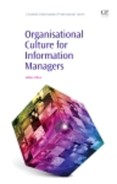Introduction
Abstract: This introduction to Organisational Culture for Information Managers provides the key information relating to the intent and purpose of the book. The scope of the book is organisational culture for information managers of all types, including both librarians and recordkeepers (records managers and archivists). Content of the book includes discussion of the concept itself and constituent layers (national, occupational and corporate culture), culminating in the introduction of the concept of information culture. Examples are provided of the practical implementation of projects tailored to suit different organisational settings.
Key words: organisational culture.
Scope and audience
The purpose of this book is to explain and explore the concept of organisational culture, specifically within the domain of information management. Understanding organisational culture is fundamentally important for anyone working in information management. In today’s digital environment the workplace is characterised by individuals creating information often independently of formal systems, or even establishing new systems without cognisance of information management requirements. Consequently, no matter how technically correct your approaches are to managing information, whether you are working in a library, records services or archives setting, if you do not take into account the organisational culture success will be patchy at best. So the overriding purpose of this book is to emphasise the significance of organisational culture, and to explain the complexity and influence of this construct.
Often ‘information management’ is defined solely from the perspective of one occupational group, and understandably so. However, it is important to stress in this book that the perspectives of groups sometimes perceived to have competing interests are taken into account. The intended audience for this book is practitioners working in all occupations that make up the information management landscape, but primarily librarians, records managers and archivists. In addition, those currently studying for qualifications in these particular occupational groups should also find much of interest and value. In order to clearly distinguish those groups, the terminology used reflects Information Continuum1 thinking. Information will often be referred to with reference to the primary purpose for which it is managed. So, information that is the focus of activities for records managers and archivists is referred to as ‘information as evidence’, managed for accountability purposes. The primary purpose of librarians is to manage information for knowledge or awareness, or for entertainment.
Structure
The book consists of seven chapters. Chapter 1 discusses the overall concept of organisational culture. It introduces the model which guides our exploration of culture in organisations, which is a multilayer one acknowledging the context in which the organisation exists. It explains why understanding organisational culture is so important for information managers and presents the ideas of the leading thinkers in this field. Particular attention is paid to the organisational culture theory of the Dutch anthropologist Geert Hofstede, as this is referred to throughout.
Chapter 2 focuses on the first and most fundamental layer in our cultural model: national culture. Again, the theory that is covered in most detail is that of Hofstede, and the characteristic dimensions identified by him are assessed in terms of their implications for information management. The following chapter departs from our layered organisational model by identifying structural features that influence organisational cultures. These structural features include language (considerations relating to the use of different character sets, and multiple languages), regional technological capabilities and the regulatory environment (particularly focusing on the laws which are so crucial to information management such as privacy, copyright and freedom of information). Legislation is culturally relevant from two perspectives: first in terms of its manifestation at a jurisdictional (national or regional, for instance) level and secondly in terms of employee awareness and acceptance of its provisions. These areas will greatly influence what happens as regards information management in organisations.
Chapters 4 and 5 each consider the two remaining layers of our organisational culture model: occupational and corporate culture. Occupational culture refers to the characteristics associated with the occupations or professions that people belong to. These characteristics can be very influential in terms of the way that people interact with information. This chapter also consider the occupational culture of information managers. Corporate culture refers to the uppermost and most superficial layer of organisational culture, the part that is the most susceptible to change.
The purpose of the final two chapters is to link all this theory clearly to the practice of information management. Chapter 6 focuses on information culture – the manifestations of organisational culture that portray values and attitudes to information in organisations. It describes a three-level framework to use for assessment of an organisation’s information culture, and includes suggestions for how to find the relevant data for diagnosis. Finally, Chapter 7 presents a series of scenarios. These include establishing a special library service, developing a business case for a digital library, implementing an electronic document and records management system, and establishing an in-house archival repository. Each of these scenarios suggests strategies to take into account different organisational/information cultures.
Throughout the book, examples from my experience studying different organisational concepts are provided to illustrate the concepts under discussion. In addition to examples drawn from my normal working environment in New Zealand, others are taken from a series of case studies, which compared information management at three universities, each situated in places where there were likely to be cultural differences (Australia, Hong Kong and Germany). In addition, further examples are used from a period spent at Tallinn University, Estonia. Most chapters conclude with suggestions for further reading.
Understanding organisational culture and using that understanding to develop tailored strategies for information management is a demanding undertaking requiring that information managers accept that there is no one-size-fits-all approach. However, the benefits in terms of successful organisational information management that are likely to accrue will be substantial.
1.Teaching tool developed by Barbara Reed, Don Schauder and Frank Upward of the School of Information Management & Systems, Monash University.
